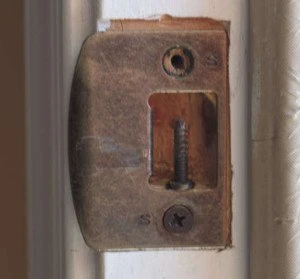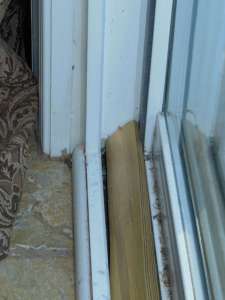Congratulations on your new house! Now is a great time to lay the foundation for a safe and secure home.
I’m here to walk you through the must-have improvements to your home that are practical and offer a significant security boost.
Purchasing a new home is a big accomplishment, and while it might be easy to get lost in the excitement of purchasing and moving furniture, decorations, and even painting, it’s also important to look into keeping your new home and family safe.
Whether you are interested in investing in a traditional home security system with professional monitoring, or you would like to set something up that allows you to do the monitoring yourself, there are plenty of options out there for multiple levels of security.
Of course, only you can decide what your risk level is and how safe you need to feel to sleep well at night!
From door and window sensors to smoke and carbon monoxide detectors, it might seem a bit overwhelming to figure out where to start. Even if you live in a place that doesn’t have a high crime rate and it seems like a good, safe neighbourhood (see how to prevent burglary by checking your probability of getting robbed), you will still get peace of mind from investing in some home security equipment (either professional or do it yourself types). Here’s a solid guide to keeping your new home as safe as possible!
How to Increase the Security of Your Doors
When you first move in, make sure that one of the most important things on your priority list is to ensure that your front, back, and garage doors are well protected. There are many different ways to go about protecting your doors, and since 70% of completed burglaries start by the intruder entering a door, keeping your home safe by focusing on the doors in your home is a vital part in home security measures.
[skill_bar heading=”Before you harden your door” percent=”100%”] [skill_bar heading=”Remaining burglaries after you follow the steps below” percent=”67%” style=”background-color: #5fb341″] We already wrote a comprehensive guide to front door security and about door security devices, but we’ll cover the must-haves again briefly here.One of the first things you should do when you move into any new home is to change the locks on all of your doors. You can’t be sure how many keys to those locks are floating around out there – maybe the previous owners kept a few. In order to be as safe as can be, make sure that changing the locks are way up on the priority – and don’t forget to install deadbolt locks on your doors as an added security measure if they don’t already have them.
If you’re buying new dead bolts, look for a long latch, drill resistant locks, and tamper proof pins to discourage picking, raking, and lock bumping.
Next, reinforce those doors! Since so many burglaries are done by breaking down the front door or back door of a home, one thing that you can do to reduce your exposure is to purchase a solid, steel-wrapped door. While these doors can still be split and broken down, it drastically cuts down ease of breaking in for the intruder, causing them to put more force into entry and taking a longer time than it would if the door was a standard wooden door.
You can even buy high security doors that still look like wood, so they’re no need to feel like you’re living in prison. You can have good looks and security.
Along those same lines, you may want to rethink doors with large panes of glass in them. While they may let a lot of light in, they’re also an easy target when a burglar is looking for a quick way into your home. At a minimum, security film (3M is recommended) on the glass can withstand multiple strikes, keep a burglar outside making noise for longer, and perhaps cause him to rethink your home as a target.

To add more security to your door, try strengthening the strike plates too. A strike plate is a small metal plate that is on your door jamb. When someone attempts to force open the door, a great deal of that force is placed on the strike plates. By adding longer screws to your strike plate and making sure it is anchored into the studs framing your door, you are adding to the amount of force that the door can handle before it yields.
Adding a door stop to your door is another way to help protect against intruders – one is the OnGuard Security Door Brace. You install the brace by screwing it into your floor up against the door. Then if anyone tries to break in by forcing the door open, they have a very difficult time getting past it since the force is stopped by the door hinges, strike plate and latch, and the door brace at the bottom. It’s a bit pricey, at $100, but is quite effective in helping to keep intruders out of your home.
However, if you have hardwood or laminate flooring, it may not be your first choice because you will have to screw it into your floor. The next person to buy your house may not be as security-conscious as you are!
A Short Guide to Securing Your Windows
While most windows already have window locks, it can be beneficial to ensure that they are working properly. Some window locks are flimsy and aren’t in proper working condition, which gives intruders an easy way to get into the home. All it takes for some locks is a screwdriver to pop them off from outside or a putty knife to slide them open, and your burglar is inside in under 30 seconds.
To secure against brute-force entries, many companies also sell window films for home security purposes – they are ultra clear, so that you may not even notice their presence on your window. They work by holding the window together for a short time after being struck with a hard object, taking vital time away from the intruder, and giving you or your neighbours more time to call the police and to prepare to defend yourselves.
Pin locks are also helpful devices to use on your windows, and are quite simple to install. By drilling a hole into your window frame, you can insert a pin that prevents the window from opening easily, preventing the window from being opened. You can use a simple nail to do the trick, or order pins for the window online (check out our post on DIY home security tips for more details).
Be careful though, you don’t want to break the seal on your windows and ruin their insulating value. You should also know that drilling into your windows may void their manufacturer’s warranty.
With that in mind, some simple rods in the tracks can be a simple and cheap alternative to pin locks.

Door and window sensors are one of the best ways to protect your home against intruders. They work by being placed on the door frame and window frame, and if an intruder forces his or her way into the home, the sensors sound an alarm. If you pair this with a home security system (either a professionally monitored system or a do it yourself system), the sensors will connect to the main hub, and notify you through your smart phone (or e-mail) that the alarm has been sounded.
If you have a professionally monitored system, the alarm company will be notified that the alarms have been activated and will call the police on your behalf. And even beyond that, a lot of systems have cellular backups so that crooks can’t just cut your internet cable coming into the house to disable your system.
The down side to a door/window sensor is that they won’t pick up on a burglar just busting the glass in a sliding door and stepping through the frame.
For that case, another helpful tool to add to your home is a glass break sensor – these can be placed in any room with doors and windows, and can sense when glass has been broken in the room, sending a notification to the main hub of your security system, which will then alert you and your alarm company, if applicable.
The same function could be done by a motion sensor in the room, but the glass break sensors will give you that extra 20 seconds of response time.
Smart Fire and Carbon Monoxide Alarms
The importance of purchasing smoke and carbon monoxide alarms has been instilled in us since we were in elementary school, and while the need for them definitely hasn’t changed, their abilities definitely have! Even if you still choose the normal variety of smoke and carbon monoxide alarms for your home, you are still adding another level of protection that will work to keep you and your family safe from disaster.
Did you know that fire causes more property loss each year than burglaries do? Make sure you’re not part of those statistics!
So, what makes smart fire and carbon monoxide alarms so special? Well, these alarms are great, especially when used in conjunction with a smart hub or security system. Smart fire and carbon monoxide alarms have the ability to detect the presence of smoke or carbon monoxide in the air, like traditional alarms, but they also have the ability to alert you about it, which is handy if you aren’t home.
Some of them even operate off of WiFi and don’t even need a hub, check out our review of the Roost Smart Battery for one of the best ones.
If the alarm goes off, the smart hub at your house will send you alerts, either through e-mail or push notifications on your smartphone. If you are using a professionally monitored security system, the alarm company will be notified of the alarms going off, contact you to verify the alarm, and then proceed to send over the fire department.
The Last Defense: Home Security Systems
Home security systems are also an obvious way to protect your new home from intruders and potential break-ins. There are so many different home security systems available, both professional and do-it-yourself style systems, and it can be difficult to figure out exactly what you are looking for when it comes to features, design, and whether or not you wish to have a contract for professional services.
But, there’s no arguing that they work.
“Most convicted burglars (90%) said they want to avoid homes with alarm systems and said if they did encounter an alarm, they would abandon the attack on the home (check out some other DIY home security tips here). So installing and using a home security system can be a great deterrent, prevent and protect against break-ins!
Also, according to a research paper titled Understanding Decisions to Burglarize from the Offender’s Perspective, which goes inside the mind of burglars and looks at their decision making progress, “83% of the burglars would try to determine if an alarm was present before breaking in, while 43% of the burglars would never continue a break-in with an alarm present (check out more burglar deterrents and statistics here). Those statistics really up your home defense odds with the purchase of a home security system!
If you are looking for some great, unbiased information to compare various home security systems from someone who isn’t trying to sell you something, check out our home security systems comparison page. It also has links to all of the systems we have reviewed in one spot.
Home security systems can be as simple as calling a professional security company to come and install the equipment. Or, they can also be more do-it-yourself focused. You can install the equipment on your own and allow professionals to do the monitoring, or you can do the monitoring too.
And don’t forget cameras! A security camera is a great way to confirm a break-in, and it’s a known fact that the police response much more quickly to a robbery that you are watching on video than a security system alert.
Final Thoughts on Securing Your Home
When you invest time and money into a new home, you want to keep it safe, so it is important to look into taking measures that will allow you to keep your home, family, and possessions safe. Reinforcing your doors, windows, and locks are a great start, as is looking into smart smoke and carbon monoxide alarms and home security systems.
And since home security systems are such a great deterrent, make sure you consider your options there too.
Throw all of these together, and there’s no reason you should be able to rest well at night knowing that you’ve done your best to protect your family and possessions.
I hope I saved you a few minutes. Be sure to sign up for more security tips and tricks if you found this article helpful.
Do me a Solid and Share this With Your Friends!



Would a sign such as “Home Protection by Smith &Wesson” attract or deter burglars?
I haven’t seen definitive research on that. But anecdotally, I have seen interviews of burglars that said they targeted home that they knew would have guns because of the value of them.
My intuition tells me that it would deter a break-in while you were likely home, but may encourage one when you’re on vacation. So, I opt to leave them guessing instead and just let them know I have cameras and a security system to take their picture and bring the police quickly.